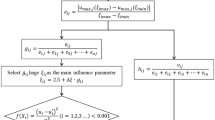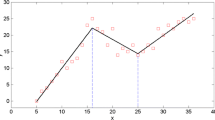Abstract
A back analysis procedure implemented in a spreadsheet environment that uses construction monitoring data for supported excavation systems to continuously recalibrate the soil parameters and thus enable updating of the lateral wall deflection predictions is presented. With this framework, the observed maximum wall deflections are used to update the soil parameters through a recently developed semi-empirical polynomial regression model. This paper demonstrates that the updated soil parameters recalibrated from the current stage of excavation can be used to predict the maximum wall deflection in the subsequent stages of excavation. The proposed framework is computationally efficient and can easily be implemented in a spreadsheet. The feasibility and effectiveness of the proposed methodology is illustrated through seven well-documented excavation case histories. The results of the case histories show that the updated soil parameters improve the accuracy of estimations of the wall deflections in braced excavations.










Similar content being viewed by others

References
Calvello M, Finno RJ (2004) Selecting parameters to optimize in model calibration by inverse analysis. Comput Geotech 31(5):410–425
Chua CG, Goh ATC (2005) Estimating wall deflections in deep excavations using Bayesian neural networks. Tunn Undergr Space Technol 20(4):400–409
Duncan JM (2000) Factor of safety and reliability in geotechnical engineering. J Geotech Geoenviron Eng 126(4):307–316
Finno RJ, Calvello M (2005) Supported excavations: observational method and inverse modeling. J Geotech Geoenviron Eng 131:826–836
Finno RJ, Harahap IS (1991) Finite-element analyses of HDR-4 excavation. J Geotech Eng 117(10):1590–1609
Hashash YMA, Jung S, Ghaboussi J (2004) Numerical implementation of a neural network based material model in finite element analysis. Int J Numer Meth Eng 59(7):989–1005
Hashash YMA, Marulanda C, Ghaboussi J, Jung S (2006) Novel approach to integration of numerical modeling and field observations for deep excavations. J Geotech Geoenviron Eng 132:1019–1031
Hashash YMA, Levasseur S, Osouli A, Finno R, Malecot Y (2010) Comparison of two inverse analysis techniques for learning deep excavation response. Comput Geotech 37(3):323–333
Hashash Y, Song H, Osouli A (2011) Three-dimensional inverse analyses of a deep excavation in Chicago clays. Int J Numer Anal Meth Geomech 35(9):1059–1075
Hsiao ECL, Schuster M, Juang CH, Kung TC (2008) Reliability analysis of excavation-induced ground settlement for building serviceability evaluation. J Geotech Geoenviron Eng 134(10):1448–1458
Hsieh PG, Ou CY (1998) Shape of ground surface settlement profiles caused by excavation. Can Geotech J 35:1004–1017
Ji J, Low BK (2012) Stratified response surfaces for system probabilistic evaluation of slopes. J Geotech Geoenviron Eng 138(11):1398–1406
Juang CH, Luo Z, Atamturktur S, Huang H (2013) Bayesian updating of soil parameters for braced excavations using field observations. J Geotech Geoenviron Eng 139(3):395–406
Koutsoftas DC, Frobenius P, Wu CL, Meyersohn D, Kulesza R (2000) Deformations during cut-and cover construction of Muni Metro Turnback project. J Geotech Geoenviron Eng 126:344–359
Kung TC, Juang CH, Hsiao CL, Hashash Y (2007) Simplified model for wall deflection and ground surface settlement caused by braced excavation in clays. J Geotech Geoenviron Eng 133(6):731–747
Ledesma A, Gens A, Alonso EE (1996) Parameter and variance estimation in geotechnical back analysis using prior information. Int J Numer Anal Meth Geomech 20(2):119–141
Li W (2001) Braced excavation in old alluvium in Singapore. Ph.D. Thesis, Nanyang Technological University, Singapore
Low BK, Tang WH (2007) Efficient spreadsheet algorithm for First-order reliability method. J Eng Mech 133(12):1378–1387
Lü Q, Chan CL, Low BK (2012) Probabilistic evaluation of ground-support interaction for deep rock excavation using artificial neural network and uniform design. Tunn Undergr Space Technol 32:1–18
Ou CY, Liao JT, Lin HD (1998) Performance of diaphragm wall constructed using top-down method. J Geotech Geoenviron Eng 124:987–1008
Pal S, Wathugala GW, Kundu S (1996) Calibration of a constitutive model using genetic algorithms. Comput Geotech 19:325–348
Phoon KK, Kulhawy FH (1999) Characterization of geotechnical variability. Can Geotech J 36(4):612–624
Samarajiva P, Macari E, Wathugala W (2005) Genetic algorithms for the calibration of constitutive models for soils. Int J Geomech 5:206–217
Tan Y, Li M (2011) Measured performance of a 26 m deep top-down excavation in downtown Shanghai. Can Geotech J 48(5):704–719
Tan Y, Wei B (2012) Observed behaviors of a long and deep excavation constructed by cut-and-cover technique in Shanghai soft clay. J Geotech Geoenviron Eng 138(1):69–88
Tang YG, Kung GTC (2009) Application of nonlinear optimization technique to back analysis of deep excavation. Comput Geotech 36(1–2):276–290
Wang ZW, Ng CWW, Liu GB (2005) Characteristics of wall deflections and ground surface settlements in Shanghai. Can Geotech J 42:1243–1254
Whittle AJ, Hashash YMA, Whitman RV (1993) Analysis of deep excavations in Boston. J Geotech Eng 119(1):69–90
Xu J, Zheng YR (2001) Random back analysis of field geotechnical parameter by response surface method. Rock Soil Mech 22(2):167–170 [in Chinese]
Xuan F (2009) Behavior of diaphragm walls in clays and reliability analysis. M.Eng. Thesis, Nanyang Technological University, Singapore
Zhang J, Tang WH, Zhang LM (2010) Efficient probabilistic back-analysis of slope stability model parameters. J Geotech Geoenviron Eng 136(1):99–109
Zhang WG, Goh ATC, Xuan F (2015) A simple prediction model for wall deflection caused by braced excavation in clays. Comput Geotech 63:67–72
Author information
Authors and Affiliations
Corresponding author
Rights and permissions
About this article
Cite this article
Zhang, W., Goh, A.T.C. & Zhang, Y. Updating Soil Parameters Using Spreadsheet Method for Predicting Wall Deflections in Braced Excavations. Geotech Geol Eng 33, 1489–1498 (2015). https://doi.org/10.1007/s10706-015-9914-4
Received:
Accepted:
Published:
Issue Date:
DOI: https://doi.org/10.1007/s10706-015-9914-4



